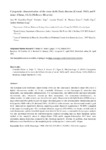Mostrar o rexistro simple do ítem
Cytogenetic characterisation of the razor shells "Ensis directus" (Conrad, 1843) and "E. minor" (Chenu, 1843) (Mollusca: Bivalvia)
| dc.contributor.author | González-Tizón, Ana M. | |
| dc.contributor.author | Rojo Oróns, Verónica | |
| dc.contributor.author | Vierna Fernández, Joaquín | |
| dc.contributor.author | Jensen, K. Thomas | |
| dc.contributor.author | Egea, Emilie | |
| dc.contributor.author | Martínez-Lage, Andrés | |
| dc.date.accessioned | 2017-07-07T10:56:29Z | |
| dc.date.available | 2017-07-07T10:56:29Z | |
| dc.date.issued | 2012-04-26 | |
| dc.identifier.citation | González-Tizón A, Rojo V, Vierna J, Jensen KT, Egea E, Martínez-Lage A (2013) Cytogenetic characterisation of the razor shells Ensis directus (Conrad, 1843) and E. minor (Chenu, 1843) (Mollusca: Bivalvia). Helgol Mar Res 67:73-82. | es_ES |
| dc.identifier.issn | 1438-387X | |
| dc.identifier.issn | 1438-3888 | |
| dc.identifier.uri | http://hdl.handle.net/2183/19229 | |
| dc.description.abstract | [Abstract] The European razor shell Ensis minor (Chenu 1843) and the American E. directus (Conrad 1843) have a diploid chromosome number of 38 and remarkable differences in their karyotypes: E. minor has four metacentric, one metacentric–submetacentric, five submetacentric, one subtelocentric and eight telocentric chromosome pairs, whereas E. directus has three metacentric, two metacentric–submetacentric, six submetacentric, six subtelocentric and two telocentric pairs. Fluorescent in situ hybridisation (FISH) using a major ribosomal DNA probe located the major ribosomal genes on one submetacentric chromosome pair in both species; FISH with a 5S ribosomal DNA (5S rDNA) probe rendered one chromosomal (weak) signal for E. minor and no signal for E. directus, supporting a more dispersed organisation of 5S rDNA compared to the major ribosomal genes. The vertebrate telomeric sequence (TTAGGG)n was located on both ends of each chromosome, and no interstitial signals were detected. In this work, a comparative karyological analysis was also performed between the four Ensis species analysed revealing that the three European species studied so far, namely E. minor, E. siliqua (Linné 1758) and E. magnus Schumacher 1817 show more similarities among them than compared to the American species E. directus. In addition, clear karyotype differences were found between the morphologically similar species E. minor and E. siliqua. | es_ES |
| dc.description.sponsorship | Ministerio de Educación y Ciencia; CTM2007-28919-E/MAR | es_ES |
| dc.language.iso | eng | es_ES |
| dc.publisher | Springer Nature | es_ES |
| dc.relation.uri | https://doi.org/10.1007/s10152-012-0305-4 | es_ES |
| dc.rights | The final publication is available at Springer via https://doi.org/10.1007/s10152-012-0305-4. | es_ES |
| dc.subject | Razor shells | es_ES |
| dc.subject | Karyotype | es_ES |
| dc.subject | FISH | es_ES |
| dc.subject | 18S-5.8S-28S rDNA | es_ES |
| dc.subject | 5S rDNA | es_ES |
| dc.subject | Telomeric sequence | es_ES |
| dc.title | Cytogenetic characterisation of the razor shells "Ensis directus" (Conrad, 1843) and "E. minor" (Chenu, 1843) (Mollusca: Bivalvia) | es_ES |
| dc.type | info:eu-repo/semantics/article | es_ES |
| dc.rights.access | info:eu-repo/semantics/openAccess | es_ES |
| UDC.journalTitle | Helgoland Marine Research | es_ES |
| UDC.volume | 67 | es_ES |
| UDC.issue | 1 | es_ES |
| UDC.startPage | 73 | es_ES |
| UDC.endPage | 82 | es_ES |
Ficheiros no ítem
Este ítem aparece na(s) seguinte(s) colección(s)
-
GI-GIBE - Artigos [83]






